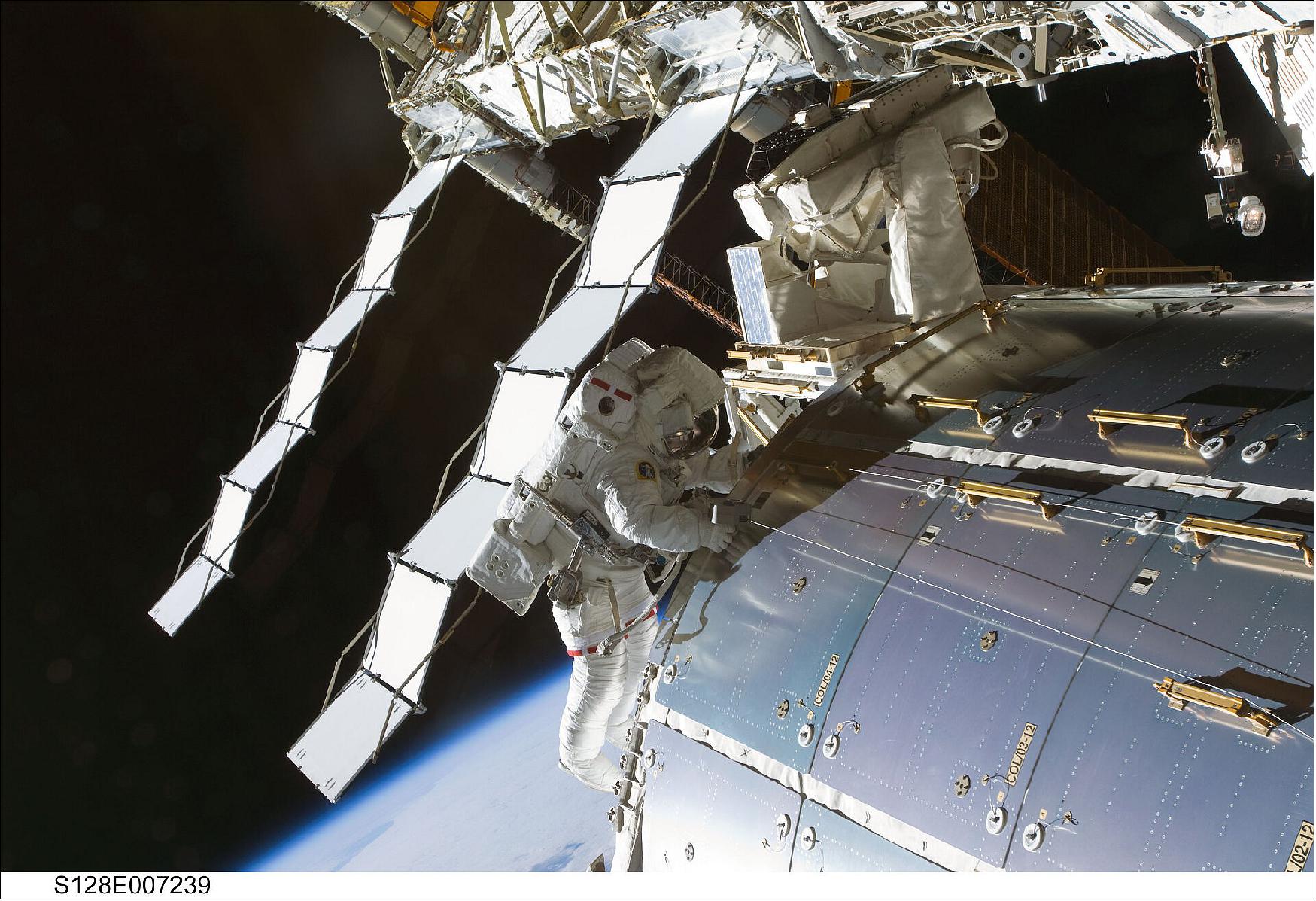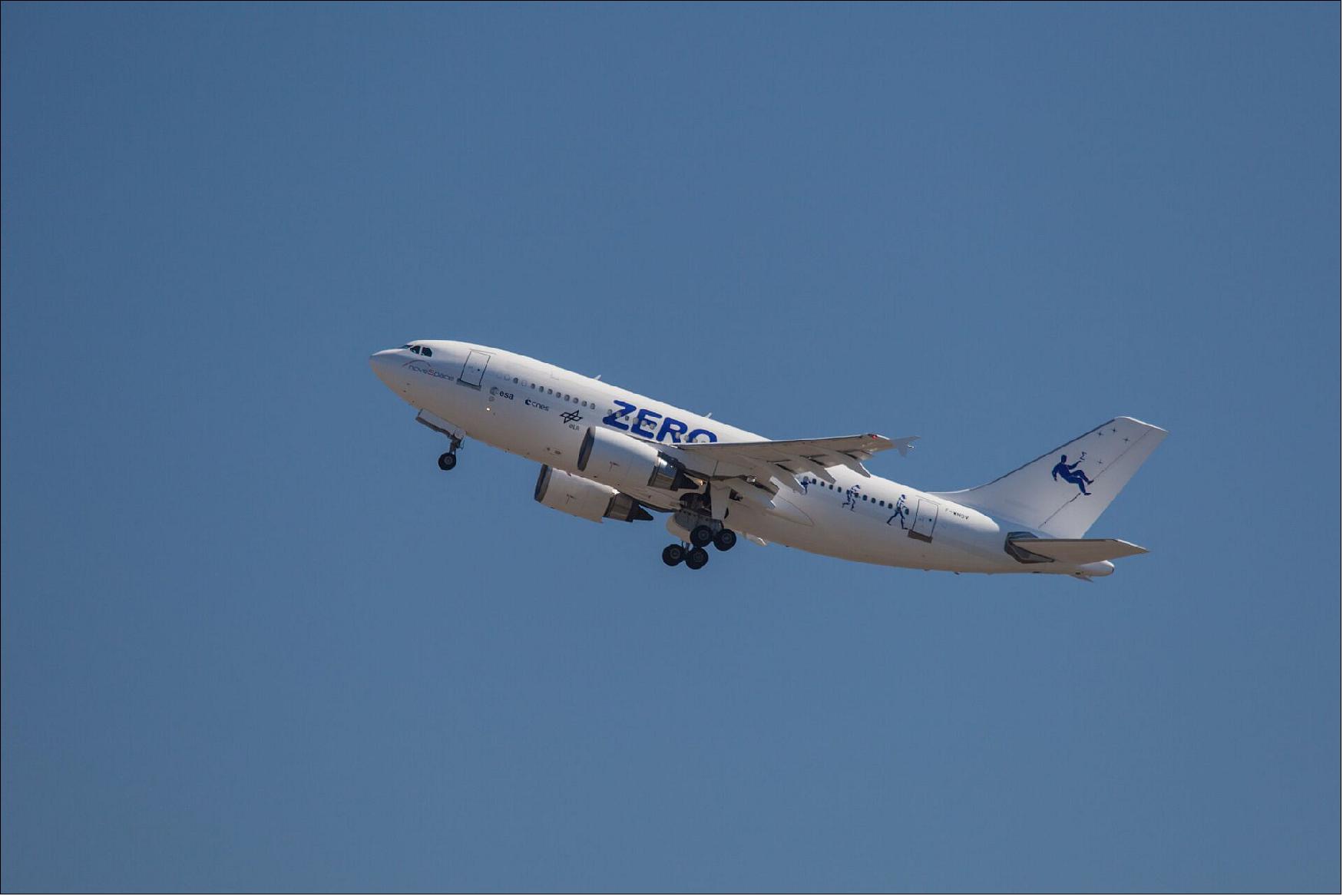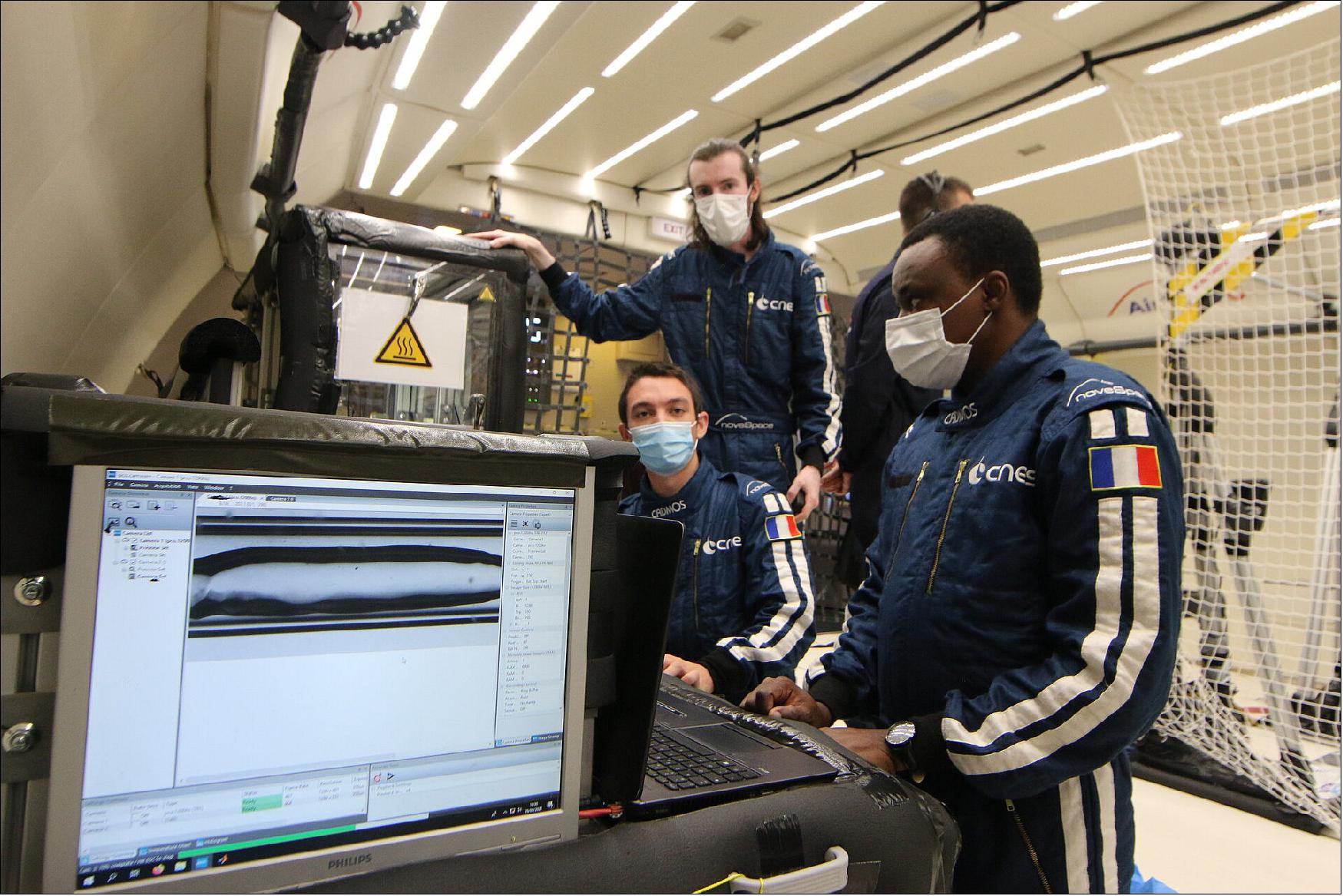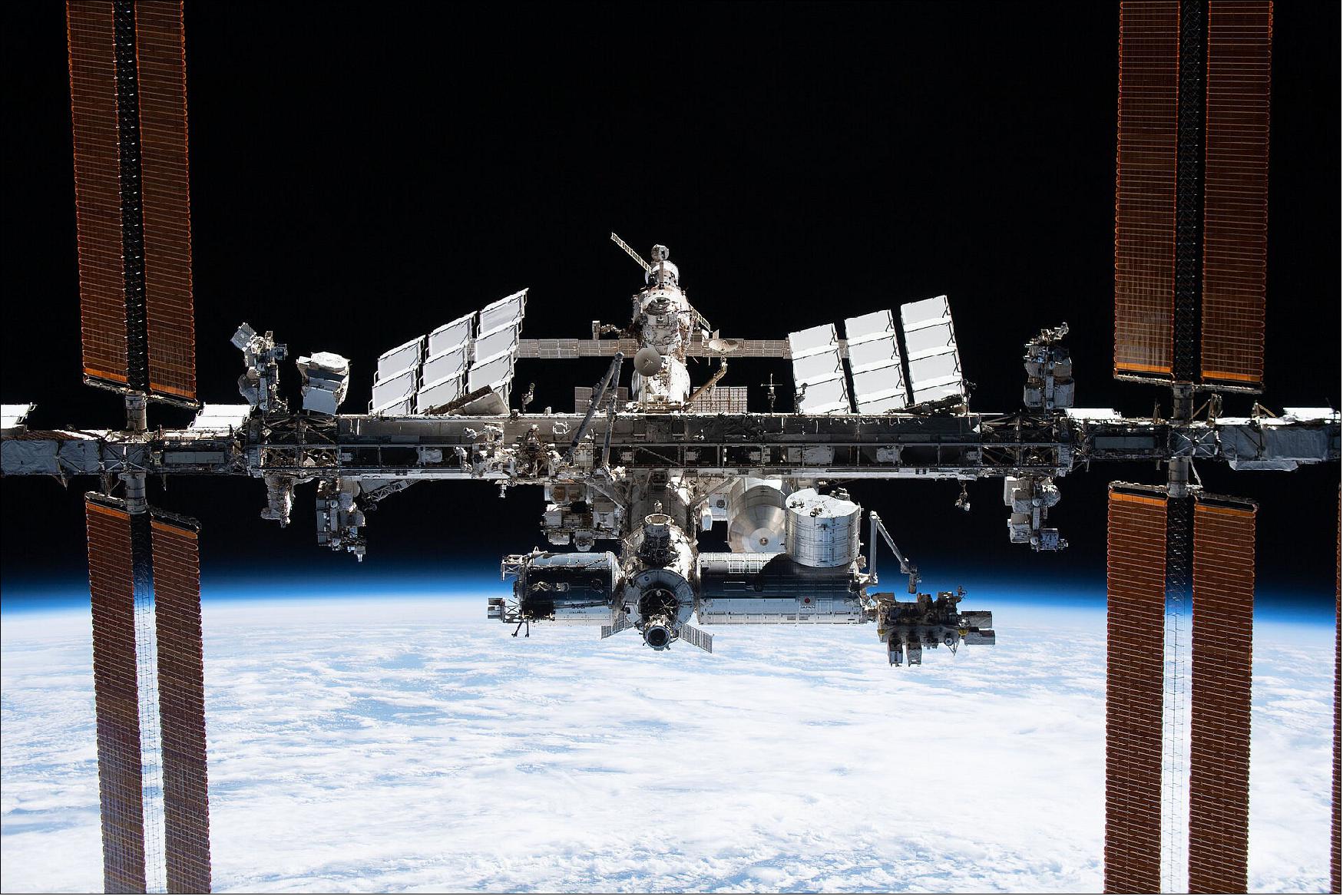ISS: Environment
Science
ISS Environment — Just Add Bubbles for a Cooler Future Spacecraft
• February 2, 2022: From soft drinks to hot tubs, people add bubbles to liquids for many different reasons. ESA engineers think bubbles produced at the verge of boiling point could help control the temperature of spacecraft in a more efficient and compact way. The main unknown is how bubbles will behave in differing gravities down to weightlessness, so researchers boarded parabolic flight aircraft for testing. 1)
Keeping systems cool in space is a major engineering problem. Both machinery and people produce waste heat as they operate, but in the same way a vacuum flask keeps your coffee hot, the surrounding space environment prevents this heat from dissipating from spacecraft.
The International Space Station (ISS), like many other crewed spacecraft, uses liquid circulated through tubes to absorb heat and pass it to external radiators – known as ‘single phase cooling’.
But ESA engineers are now looking into a more efficient variation, called ‘two phase cooling’ – already widely employed in terrestrial power plants and petrochemical processes.
It is called ‘two phase’ because it employs two separate phases of matter: liquids and gases. Counter-intuitively, the coolant liquid is heated to the verge of boiling point as it flows through the structure being cooled. Contact with waste heat makes the liquid boil into bubbles of vapour. This ‘flow boiling’ approach can transport heat away much more quickly and efficiently.
With ESA SciSpacE and Airbus Defence and Space support, the Institute of Fluid Mechanics in Toulouse designed a small compact loop for the study of flow boiling in weightlessness, fitting a circuit with a pump, a flow meter, preheaters, a condenser and associated tubing within the strictly limited volume available. A test version has been flown in ESA and CNES parabolic flight campaigns - the former producing bubbly flows in Moon, Mars and terrestrial gravities as well as in microgravity – with the eventual aim of flying it aboard the International Space Station.

“The heightened efficiency of heat transfer in boiling promises more compact and lighter thermal control system devices,” comments Sebastien Vincent-Bonnieu of ESA’s SciSpacE team. “Boiling is a complex phenomenon however, combining heat and mass transfers, hydrodynamics, instabilities and interfacial phenomena.
“Furthermore, gravity affects the fluid dynamics and may lead to unpredictable performances of thermal management systems in microgravity conditions. We therefore decided to perform experiments directly in (near) weightless environments using ESA’s 'Zero-G' Airbus A300 for parabolic flights.”

Supported by ESA and Airbus Defence and Space, the Institute of Fluid Mechanics of Toulouse (IMFT) led by Prof. Catherine Colin designed a small compact loop for the study of flow boiling in weightlessness, fitting a circuit with a pump, a flow meter, preheaters, a condenser and associated tubing within the strictly limited volume available.
“This loop is planned to be installed aboard the ISS’s Columbus module, perhaps in the new version of the European Drawer Rack, EDR2,” explains Balazs Toth, ESA payload system engineer.
“To validate the design, a test version has been flown in ESA and CNES parabolic flight campaigns - the former producing bubbly flows in Moon, Mars and terrestrial gravities as well as in microgravity,” comments Olaf Schoele-Schulz, Project Manager from Airbus. “The experimental device proved fully operational, opening the way to follow-up investigations in-orbit.”

Cameras placed within the test device showed the bubbling liquid’s flow was unperturbed even as it moved a short distance downstream from 90º ‘elbow’ bends in the loop.
Boiling Point
Microgravity boiling is a topic being probed by multiple European teams, variously performing experimental, theoretical and numerical research, coordinated through the Multiscale Analysis of Boiling Microgravity Application Programme or MAP project, overseen by Prof. Colin.

“Understanding and modelling of the boiling phenomenon requires complementary investigations at different scales: from microscopic scale with isolated bubbles to macroscale with flow boiling in a tube,” adds Julien Sebilleau from IMFT. “The Multiscale Boiling RUBI payload launched to the ISS in July 2019 and operated for a year and a half has been investigating boiling at individual bubble scale.”
“Parabolic flights have meanwhile enabled larger-scale testing, but to go further, longer and better requires prolonged microgravity conditions,” adds Sebastien. “So we are looking forward to flying our flow-boiling experiment aboard the ISS.”
Cosmic Pearl
It can be hard to appreciate that a human-made, football-pitch-sized spacecraft is orbiting 400 km above our heads, but there it is. 4)

Crew-2 got these amazing views during a flyaround of the orbiting lab after undocking from the Harmony module on 8 November, before their return to Earth.
Since this image was taken, there has even been a new addition in the form of the Russian Node Module, known as Prichal. The final Russian module planned for the Station, it is a spherical node attached to the Russian segment with six docking ports for future Progress and Soyuz arrivals.
A collaboration between five space agencies, the Station has become a symbol of peaceful international cooperation for 23 years now. It represents the best of our space engineering capabilities as well as humankind’s pursuit of scientific knowledge and exploration.
By any standards, it is an incredible piece of spacecraft engineering. Weighing 420 tonnes, it travels in low-Earth orbit at more than 27 000 km/hour, circling Earth approximately 16 times every day.
Crew members conduct scientific research in microgravity at facilities such as ESA’s Columbus module. Some of these experiments and tests are preparing the way for human exploration of the Moon and beyond. But the Station also provides a unique view of Earth, while its science benefits life on our planet.
Current ESA astronaut in residence is Matthias Maurer, a first-time flier spending around six-months in orbit for his Cosmic Kiss mission. Matthias will continue to support a wide range of European and international science experiments and technological research on the Station before handing off to the next ESA astronaut to fly, Samantha Cristoforetti.
References
1) ”Just add bubbles for cooler future spacecraft,” ESA Enabling & Support, 2 February 2022, URL: https://www.esa.int/Enabling_Support/
Space_Engineering_Technology/Just_add_bubbles_for_cooler_future_spacecraft
2) ”Ammonia radiators on Station,” ESA Science & Exploration, 15 May 2013, URL: https://www.esa.int/Enabling_Support/
Space_Engineering_Technology/Just_add_bubbles_for_cooler_future_spacecraft
3) ”Bubbles from Multiscale Boiling experiment on Space Station,” ESA Science & Exploration, 10 September 2019, URL: https://www.esa.int/Enabling_Support/
Space_Engineering_Technology/Just_add_bubbles_for_cooler_future_spacecraft
4) ”Cosmic pearl,” ESA Science & Exploration,” 30 November 2021, URL: https://www.esa.int/Enabling_Support/
Space_Engineering_Technology/Just_add_bubbles_for_cooler_future_spacecraft
The information compiled and edited in this article was provided by Herbert J. Kramer from his documentation of: ”Observation of the Earth and Its Environment: Survey of Missions and Sensors” (Springer Verlag) as well as many other sources after the publication of the 4th edition in 2002. - Comments and corrections to this article are always welcome for further updates (eoportal@symbios.space).